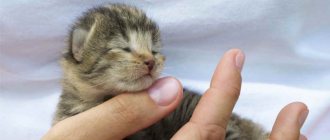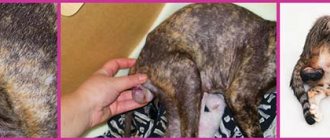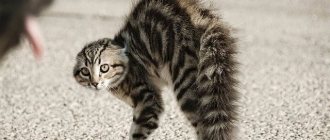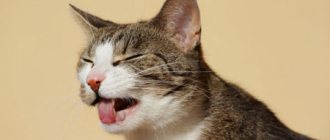Cats 50394
Childbirth is quite stressful for cats, as it is for absolutely any woman giving birth. Often, cat psychology, already poorly understood by people, changes significantly after the birth of offspring. You can often observe how a pet bites its babies, hits them with its hind legs or drags them by the scruff of the neck, while the kittens squeak.
The owners, alarmed by this behavior of their pet, begin to sound the alarm. However, not every mother cat nibbling on her litter is a danger signal. In this article we will try to understand when the behavior of a new mother is within the normal range, and when it is worth worrying about.
Bites as a method of raising offspring
A cat who has become a mother faces a difficult task: she needs to teach her litter everything she knows in the shortest possible time. This is required so that the kittens are ready for independent living. Moreover, in the wild, such activities would ensure their survival. At the same time, cats have much less time at their disposal than people have to raise their children.
You don't have to worry if your pet bites the kittens without leaving marks on their skins. As a rule, educational biting lasts until the baby makes a loud cry. With his voice, he lets his mother know that he understands everything, and, satisfied with this signal, she lets him go.
Why does a cat bite its kittens?
These animals have a well-developed maternal instinct. But sometimes owners are surprised by the unusual behavior of cats that have just become mothers. Mother cats show far from a warm maternal attitude towards their offspring. They can bite blind cubs and growl at them. What's the matter? Let's learn about the typical reasons for this behavior of new mothers.
Parenting with bites
We use the carrot and stick method when raising our children. A cat does the same thing. But nature gave her much less time for feeding and raising her offspring. Usually after 2-3 months the mother will be ready to bear kittens again, and in such a short period of time she must teach the cubs to survive in the harsh world.
Therefore, the cat sometimes uses not only biting kittens, but also hits them with her paw. In this way, the mother tries to instill in the children the rules of conduct, teaches how not to behave. At such moments, she can bite the kitten without causing injury until he understands what is required of him. The cat always makes sure that all children are in her field of vision, in the nest and do not try to leave it.
Biting as an educational measure occurs when the cat gets tired, wants to sleep, and children climb on it like on a playground. She calms annoying and nimble children in this way. By the way, if dad lives next to his mother cat, then he can raise his offspring in the same way. This is how daddy cat demonstrates his authority and dominance.
The cat does not want to feed her kitten and starts hitting him. Why do you think she does this? Why is this so...
Calm down or protect from danger
The psychology of the cat family is radically different from that of humans, and yet, in some ways we are similar. These animals, just like people, have their own methods of raising and protecting babies from danger.
Where a human mother would slap a naughty fidget on the butt, a cat mother will in the same way tell her baby how not to behave by biting the scruff of the neck. She can punish the kitten if it gets too excited and runs around, ceasing to notice everything around it. And also if the baby, being in a playful mood, climbs up to her, and in the meantime she tries to take a nap and replenish her strength.
A cat is capable of biting the skin of kittens that are trying to get out of the nest if she thinks that it is too early for them to do this. She will definitely claw her by the scruff of the neck or even hiss threateningly, not letting her onto the balcony, which, in her opinion, can be dangerous for furry fidgets.
You don’t have to worry if you notice how the mother stands over the baby and then takes his scruff in her mouth, then lets go. There is a high probability that at this moment she is not trying to harm him, but, on the contrary, wants to move him to a safe place. She just can't do it for some reason. Probably, the pet cannot figure out how best to lift it so as not to harm it. This sometimes happens, however, after several attempts, as a rule, the cat copes with the task.
Biting as a way to calm and protect kittens
If we put the psychology of representatives of the cat family and the psychology of people on the same level, then, of course, we can say that they are completely different. And even then, some quite striking similarities can be mentioned in our behavior. For example, in cats, so Just like people, write down their own methods of raising kittens, as well as protecting and protecting them from danger.
If people try to calm down unruly babies by giving them a tiny smack on the butt, then the cat seems to perform the same action, biting the kitten in the scruff area. The cat mommy may well get angry and punish the baby in this way, who suddenly becomes cheerful and rushes around the house, noticing nothing untoward on his way. Sometimes adult cats just fight back against kittens who are in a playful mood and do not allow the mother to catch her breath and replenish her strength.
Often cats bite their offspring by the neck, preventing them from getting out of the box or other place specially equipped for them. This usually happens if the cat thinks that it’s still too early for the kids to wander around the entire apartment. A mother cat may bite and even angrily shush if she sees that the kittens have headed to the balcony or to another room that, in her opinion, is dangerous.
Don't worry if you witness a cat grabbing a kitten by the scruff of the neck, dragging it somewhere, and then letting it go. Most likely, she does not at all seek to cause him any harm, but, quite the contrary, is trying to block him in this way. Sometimes, in an attempt to protect your kitten from a perceived danger, a grip can cause harm to the baby by carelessly picking it up with your teeth. As a rule, this happens the first time; over time, the bride’s mother learns to do it correctly.
The Art of Hunting
Don’t let it come as a surprise to you when your pet begins to teach her offspring to hunt. At the beginning of classes it will look something like this: the mother cat firmly grabs the kitten with her front paws and beats on him with her hind paws. At the same time, she alternates between biting and licking him. In addition, it can purr loudly, encouraging it to learn.
At the initial stage of training in the art of hunting, the cat demonstrates with its kittens how to properly capture and subdue the prey. In addition, the ability to suppress will be needed by the young when they grow up and begin to defend their rights to territory and dominance. And believe me, in a couple of weeks you will already be watching kids practicing these techniques on each other.
When the litter grows a little more and begins to crawl out of the shelter, a slightly different picture will open before you. In addition to the training activities described above, demonstration hunting jumps and pursuit will be added. Mommy, by personal example, will show the children how to sneak, wait and suddenly jump on the victim. Everything will remain the same with the squeak: if you meow, you understand. As before, the young animals will continue to practice the techniques both among themselves and on the mother.
Kitten bites by mother: parenting methods or a warning sign about problems?
raising a baby kitten.
Carefully observing the relationship between a cat and kittens, owners often notice that the pet does not show very warm and tender feelings towards its cubs. The reasons why a cat bites its kittens usually lie in ancient natural instincts, but sometimes they are also caused by external factors.
Nature has not given a cat much time to feed and raise its offspring. As a rule, after 2 - 3 months the female is again ready for fertilization and gestation. Therefore, in a short period of time, the mother must raise and teach her cubs the laws of survival in harsh reality. At the same time, the learning process involves not only biting the baby; those who are especially slow-witted can get hit with a paw.
Taking care of her offspring, the mother closely monitors that all the kittens are in her field of vision, in the best case - in the nest. And if a particularly nimble and restless baby constantly tries to leave the house, tries to crawl away or run away, the cat applies appropriate educational measures to him, bites him and demands obedience.
Quite often, the mother herself accustoms her babies to the tray. And if the kitten does not understand what is required of him and refuses to go to the toilet in a specially designated place, the pet, as a rule, takes strict measures to raise the careless cub.
A mother cat may bite her kittens when she is tired, wants to rest, and naughty children are too annoying and disturb her.
Not only the mother, but also the father can teach the baby to be smart. The reasons why a cat bites a kitten on the neck are often related to the educational process and the establishment of authority. This happens if the father lives in the same room with his offspring, or when a kitten comes into the house where an adult male lives.
Self defense lessons
In the wild, a young animal faces various dangers. Therefore, the task of any mother is the need to teach her offspring to repel the enemy. And even though domesticated cats are no longer threatened by serious predators, nevertheless, at the genetic level, the pet must teach its offspring self-defense skills.
Therefore, you can often see a picture of a cat biting kittens on the neck. Thus, the animal shows which place is the most vulnerable in a fight with an opponent, in the fight against a predator, and teaches kids to avoid the invasion of a stranger into this part of the body. Self-defense lessons are usually held in the form of a game. The mother does not cause serious injuries to the kitten; she does not bite painfully, slightly squeezing the skin.
We suggest you read: Conjunctivitis in cats











